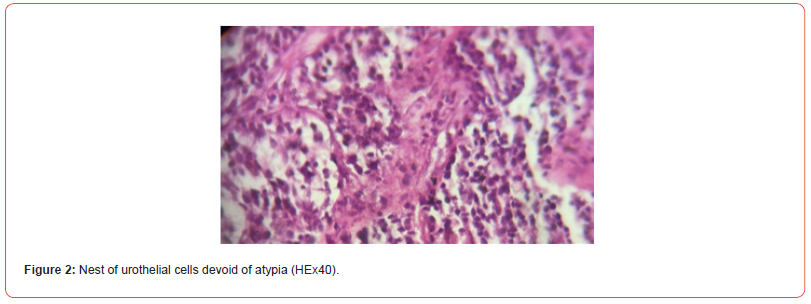 Case Report
Case Report
Benign Tumor Mimicking Invasive Urothelial Carcinoma: Inverted Urothelial Papilloma of the Bladder
Imane BOUJGUENNA1*, Fatima BOUKIS2 and Youssef KADOURI3
1Faculty of Medicine and Pharmacy of Guelmim - Ibn Zohr University Agadir, Morocco
2Al AMAL Pathological Anatomy Laboratory of Guelmim, Morocco
2Department of Urology, Guelmin Regional Hospital, Morocco
Imane BOUJGUENNA, Faculty of Medicine, and Pharmacy of Guelmim - Ibn Zohr University Agadir, Morocco
Received Date:March 11, 2024; Published Date:March 18, 2024
Abstract
Inverted urothelial papilloma is a benign neoplasm with endophytic development and anastomosed insular and trabecular architecture. We report the case of a 72-year-old patient with no significant medical history who presented with minimal hematuria. Physical examination was unremarkable. Cystoscopic exploration revealed an intravesical polyp that was resected. Histopathological examination concluded an inverted urothelial papilloma. Follow-up was indicated. The evolution was unremarkable.
Keywords: Inverted papilloma; pathological anatomy; diagnosis
Background
Inverted urothelial papilloma is a benign neoplasm with endophytic development and anastomosed insular and trabecular architecture. The objectives of our work are to report a case of inverted papilloma.
Medical Observation
A 72-year-old patient with no significant medical history was presented with macroscopic hematuria with no other associated urinary or extra-urinary signs. The physical examination was unremarkable. Cystoscopic exploration revealed an intravesical polyp that was resected. Macroscopic examination showed a polypoid fragment measuring 2mm. Microscopic examination revealed urothelial mucosa with benign tumor proliferation with endophytic development. It consisted of nests, cords, and anastomosed trabeculae. The cells were of medium size with regular nuclei devoid of atypia (Figures 1&2). The conclusion favored a completely excised inverted urothelial papilloma. Followup was indicated. The evolution was unremarkable.
Discussion
Inverted urothelial papilloma is a benign neoplasm with endophytic development and anastomosed insular and trabecular architecture [1]. Inverted papilloma of the bladder is a rare benign tumor representing 1 to 2.2% of bladder tumors [2]. Inverted papilloma of the bladder typically appears in the fifth and sixth decades of life with a mean age of 59 years, with significant male predominance and a sex ratio ranging from 5 to 8 [3]. Our patient had macroscopic hematuria alone or associated with other urinary signs, which is the revealing sign in more than 50% of cases [4], as was the case with our patient. Cystoscopic appearance is in the form of a non-invasive polypoid tumor in the trigone and vesical neck, which remain the preferential locations with a frequency of 84.5% [5-7]. The diagnostic criteria in the 2022 WHO classification of urinary tract tumors are the presence of benign urothelial tumor proliferation with endophytic development, and squamous metaplasia is possible. The main differential diagnosis is invasive urothelial carcinoma due to the endophytic development of the tumor and the presence of cytonuclear atypia that distinguishes it. Treatment relies on endoscopic resection with surveillance by flexible cystoscopy every 4 months in the first year and then every 6 months for the next 3 years. Systematic surveillance of the upper urinary tract is not deemed necessary [8,9], given the risk of association with urothelial carcinoma.
Conclusion
Inverted papilloma is a rare tumor that remains unfamiliar to urologists and poses a problem of differential diagnosis with urothelial carcinomas for pathologists. Association with malignant tumors is not uncommon and requires regular surveillance (Figures1&2).


Acknowledgment
None.
Conflict of interest
No conflict of interest.
References
- (2022) Urinary and Male Genital Tumours. WHO Classification of Tumours, 5th Edition, Volume 8.
- Assor D (1976) Inverted papilloma of the renal pelvis. J Urol 116(5): 654.
- Picozzi Stefano, Casellato Stefano, Bozzini Giorgio (2013) Inverted papilloma of the bladder: a review and an analysis of the recent literature of 365 patients. Urol Oncol 31(8): 1584-1590.
- Hicham El Bote, Sihem Atik, Rami Fares, Ernest Hage (2017) Inverted papilloma of the bladder: a rare benign tumor: a case report. Pan Afr Med J 26: 204.
- Romanelli R (1986) Inverted urothelial papilloma. Report of five cases and review of the litterature. Pathologica 78(1053): 89-97.
- Henderson DW, Allen PW, Bourne AJ (1975) Inverted urinary papilloma: Report of 5 cases and review of the literature. Virchows Arch A Pathol Anat Histol 366(3): 177-186.
- Matz LR, Wishart VA, Goodman MA (1974) Inverted urothelial papilloma. Pathology 6(1): 37-44.
- Ho Henry, Chen YD, Tan PH (2006) Inverted papilloma of urinary bladder: is long-term cystoscopic surveillance needed? A single center’s experience. Urology 68(2): 333-336.
- Cummings R (1974) Inverted papilloma of the bladder. J Pathol 112(4): 225-227.
-
Imane BOUJGUENNA*, Fatima BOUKIS and Youssef KADOURI. Benign Tumor Mimicking Invasive Urothelial Carcinoma: Inverted Urothelial Papilloma of the Bladder. Arch Clin Case Stud. 3(5): 2024. ACCS.MS.ID.000572.
-
Inverted papilloma; pathological anatomy; diagnosis; iris publishers; iris publisher’s group
-

This work is licensed under a Creative Commons Attribution-NonCommercial 4.0 International License.






